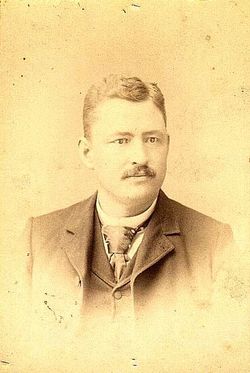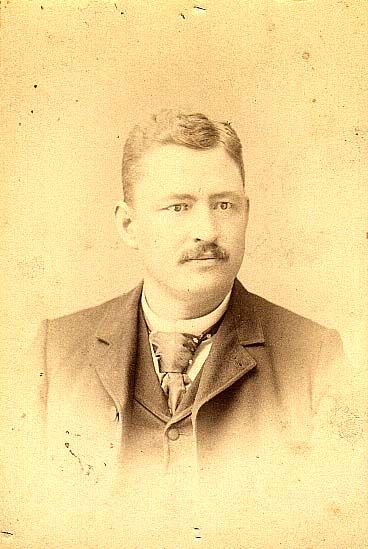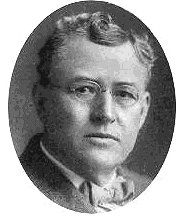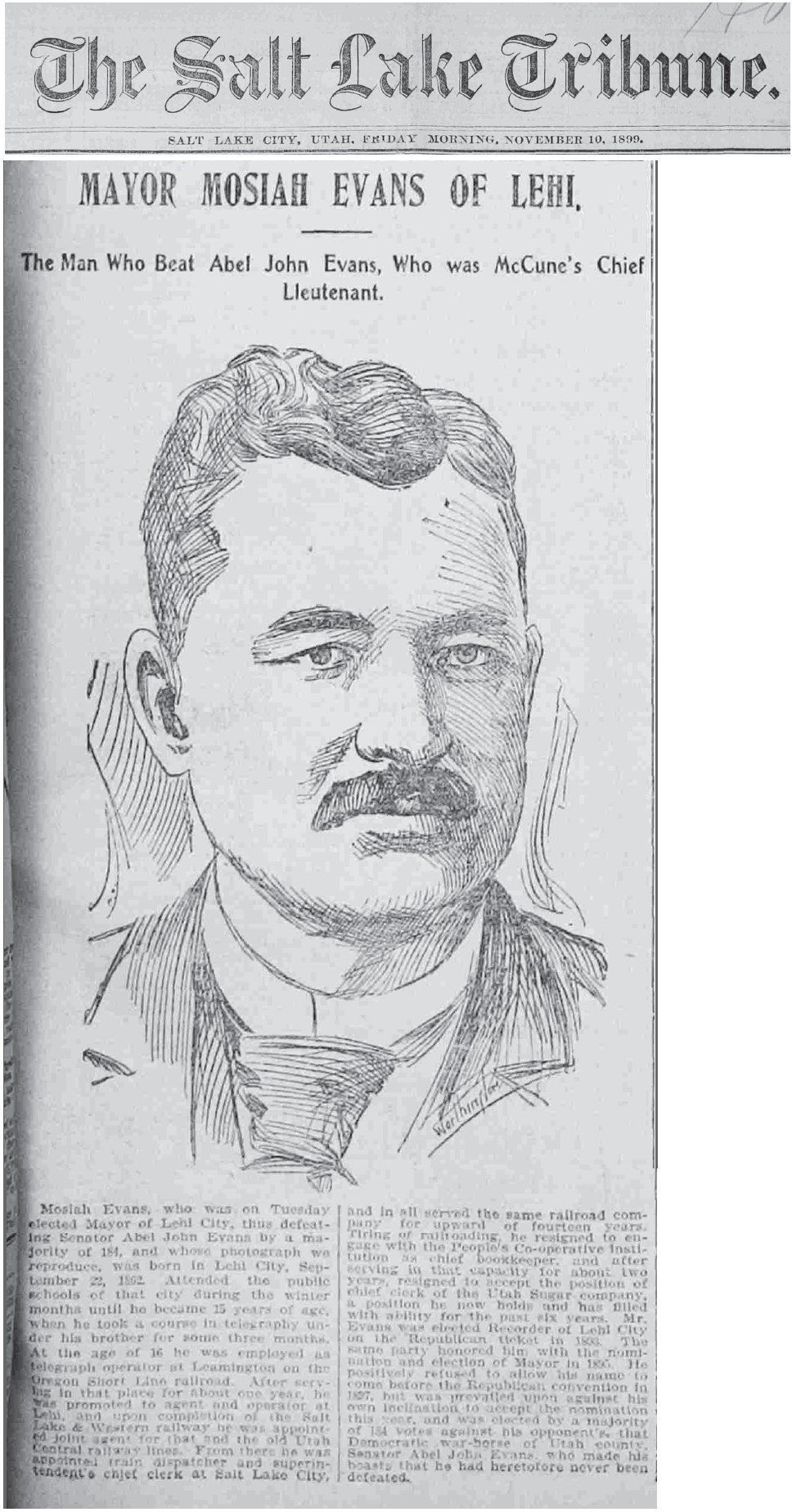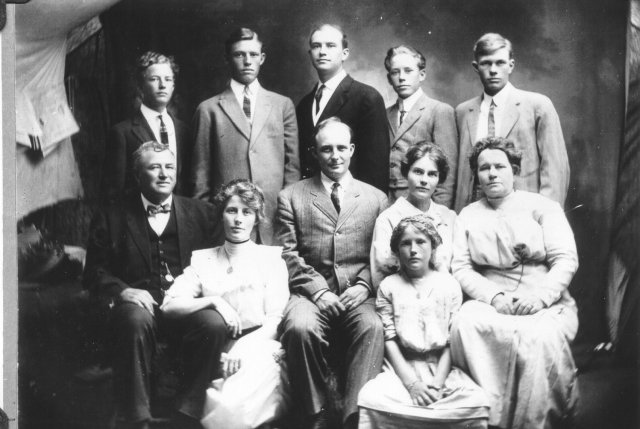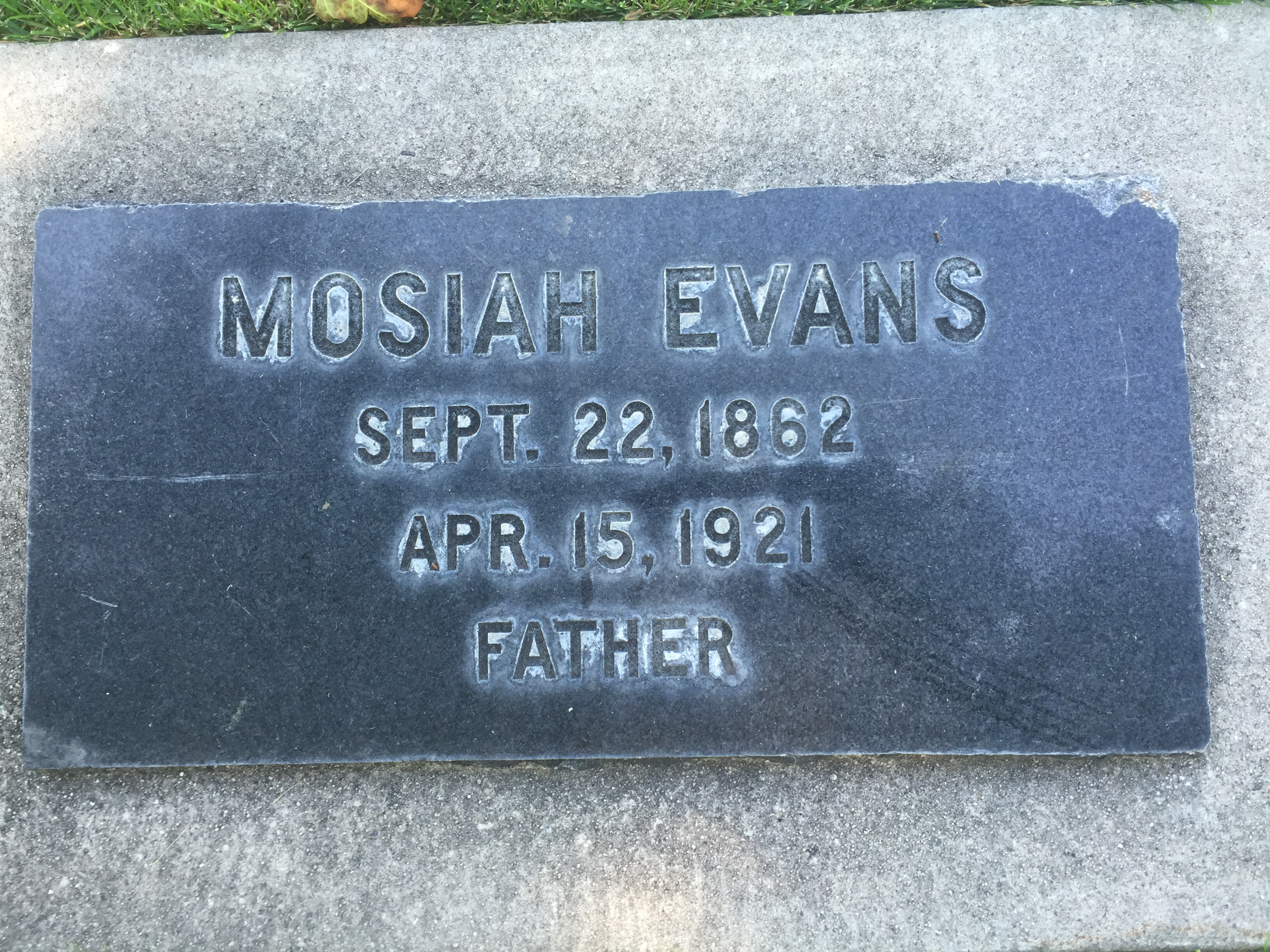Young Mosiah's twinkling dark brown eyes, a characteristic of the majority of his father's children marked him as one of those "Evans papooses" as the Indians designated them. His hair was also brown and from wavy to curly depending on the weather. His complexion was fair. His body was well proportioned and responsive. His native ability and good common sense coupled with an enthusiastic interest in everything about him frustrated what might otherwise have been the result of a totally limiting formal education.
His three "Rs" consisted of three or four grades in a one-room school situation plus tutoring by members of his family. He later was taught telegraphy by his older sister Barbara who in 1870 had become the first telegrapher in Lehi for the Deseret Telegraphy Lines. When the line was abandoned in 1872, Barbara became operator in Lehi for the Utah Southern Railroad. Through her encouragement and recommendations, young Mosiah applied himself to the mysteries of the strangely spaced clicks and himself became a capable and respected telegrapher for the railroad. Years after leaving telegraphy, as a profession, he would stop by a dispatcher's office to hear the click of the key. It too was not uncommon occurrence for him to recognize the individual who from a far away place was keying a rhythm that Mosiah's sensitive ear could recognize as a friend he had know years before.
On the 14th of December, 1882, Mosiah married Catherine Esther Carter in the Endowment House in Salt Lake City. Esther, as she was known, was the third child of James Perry and Harriet (Wood) Carter. She was born 12 May 1859 at Tredegar, Wales, but a few days after the death of her older brother, Josiah, and sister Elizabeth Ann. James, his wife, and Esther came to America and to Utah in 1861. It was on the Big Sandy, Utah Territory (now Laramie, Wyoming) that the fourth child was born to James Perry Carter and Harriet Wood. Her name was Rosalee. She was followed by four additional Carter children: Harriet Jane, James, Clara Cleopatra, and Nesey Maud in Salt Lake City, Utah. The Carters, sometime around 1870, established themselves in the north of Third Ward area of Lehi--also called "the new survey," Lehi junction, and "over the creek."
Mosiah continued his work with the railroad for some ten years following his marriage, during which time they had four children: Mosiah David James (or Mosie), Esther Maud (also known as Essie or Dot), Howard, and Hazel May. Upon separation from the railroad, he associated with the Lehi Co-op as a bookkeeper and accountant. This second period marked an increase in their family by three: Eleazar Carter (or Azer), John Rosco (or Ross), and Glen Merrill (or Pat). Sometime during the Co-op he started buying into a Bear River land and water development venture together with T.R. Cutler, George Austin and others.
During this same Co-op period, he entered the political arena to become City Recorder in 1893. The November election of 1895 brought him the honor and responsibilities of Mayor. In 1897, the prohibition issue of the Democrats edged Mosiah out of office, but in November of 1899, Mosiah was returned to office with a mandate to return the community to his former policy of high license and strict regulation. In November of 1900 Mayor Evans was elected to the state legislature and so resigned his position as chief executive of Lehi. George Austin was appointed to succeed him. Two year later this was reversed when Mayor Austin was elected to the State Legislature and Mosiah was appointed to complete Mr. Austin's term as Mayor--November 1901 to November 1902.
Early in his political activities, Mosiah left the Co-op to become bookkeeper and accountant for the Lehi Bank. During the back period, two additional children Earl William and Jesse Virginia joined the family. It was not until the Garland period that the last child Lyra Alice was stillborn. The Bank period and his Lehi political life were brought to a close when Mosiah accepted a bid to serve the Utah-Idaho Sugar Co. as resident Manager in the building of a new factory at Garland, Box Elder, Utah.
The Garland period was preceded by a season of week ending with the family in Lehi and working through the week at Corinne, Utah, where preliminary planning was carried on and from where the building of the factory and various town facilities was directed. In the fall of 1904 the family moved to Garland. In 1905 Mosiah was elected first president of the Garland town board. He helped organize the Garland Commercial Club and served as its president in 1907 and 1912. He served extended terms as President of the Bank of Garland and the Garland Athletic Association. He attracted a doctor to the Garland area by establishing a drug store, offered switch board space in this same drug store and so attracted the telephone. His daughter Essie became the first "Central" as well as drug store clerk.
Mosiah Evans
It was during the Garland period that the family started their dispersion into homes of their own. Young Mosiah, "Mosie" married Bessie Preston in 1906. He remained in Garland, first working for the Sugar factory and then as cashier of the bank for about ten years when he moved to Alameda, California. At the time he moved to California he requested that the family discontinue calling him Mosie and he became known as M.D. All of his children (3) were born in Garland. Esther or Essie married David B. Foulger the spring of the following year. David and his brother Herbert were in the mercantile business with Herbert doing portrait photography as an additional service. Two of the children of Essie and Dave were born in Garland after which they moved to Ogden, David's home town, where the other two children were born. Howard married Grace Elva Harding and after the birth of their first three children they moved to Payson, Utah where the fourth of their family was born. Hazel May married a Salt Lake man, David Charles Chapman. Their first child, Esther, was a Garland daughter while the other four were born in Salt Lake City (Virginia, Caroline, David Marden, and Eugene Henry). Eleazar (or Azar) married Annie Garfield in 1915. They adopted a daughter in Garland and later a son in Carlin, Nevada. Glen Merrill (Pat) married Pearl Pansy Phelps. Their first, a Garland son, was born shortly before they moved to Los Angeles, California, where their other child, a daughter, was born. The three remaining children of Mosiah and Esther married somewhat after the Garland period as follows: John Roscoe (Ross) married Bertha Grace Backlan following his release from the Army, having served in France during the ware that was to make the world safe for democracy. Their three children were born and raised in California. Earl William married Marie Haggard in the Northwest. Marie passed away and following her (2) Helene suffering from the same infection also passed away. Earl has since married (3) Mary Seyfert. They live in North Hollywood, California. Jessie Virginia marked Raymond Clarke Dickinson in Seattle, Washington. They had a daughter and three sons.
The forgoing has reviewed that which Mosiah Evans did in a business and civic way, refusing to accept the limitations that an inadequate formal education might otherwise have occasioned. His climb to a respected position in both business and political levels as delineated does not tell sufficiently of his true character! Mention must be made of the warm, gentle love that existed between him and his wife and as they came to them, to each child member of the family. It stands as a testimonial of his deep inner kindness and gracious respect for others. A like feeling for him was returned by all who enjoyed his friendship. Aunts, uncles, brothers, sisters, and cousins have left expressions of the good will and fellowship existing between Mosiah and his many relations. Throughout his his life he had a youthful, vital , involved interest in the wonders of nature and science and in the ever changing social scene. Not satisfied to enjoy alone he invited others to share in the enjoyment of each passing event. He, with all his other interests and responsibilities, was still ready to patiently show and explain the inner workings of some current advancement in science or community improvement. His children were taken to state and local celebrations, the fair, resorts. He and his wife visited Yellowstone Park when the National Park Service and western tourism were still in their infancy. His grandchildren who knew them remember the almost hedonistic enjoyment of a visit to the home of Grandpa and Grandma Evans.
In the summer of 1916, Mosiah, Esther, and Jessie, their youngest, moved to Spanish Fork, Utah where he continued his work with the sugar company. He remained there for just short of three years and then moved to Salt Lake City where he passed away the 15th of April, 1921. His wife sold the home and moved to California where she established residence in an apartment adjoining the apartments of Wallace Hodge and of his sister Catherine Hodge Collette. The Hodge people were children of Mosiah's sister. After a time she gave up her apartment and commenced "visiting" her children. It was during one such visit to her daughter Essie in Ogden, Utah, on 27 December, 1941 that she was "called home." Mosiah and Esther are buried in the Lehi Cemetery.
MOSIAH EVANS, Sixteenth Mayor of Lehi
1899-1900 1902-1903
The verdict of the voters on November 7th,1899, was that the previous Democratic administration of Prohibition had not been successful, so they showed their disapproval of that party by electing the Republican ticket on a platform which decided for the former policy of high license and strict regulation.
That ticket was as follows; Mosiah Evans, Mayor; Samuel Taylor, William Bone, Elias A. Bushman, George Austin, and Richard Bradshaw, Councilors; James E. Ross, Recorder; J.N. Butt, Marshal and Stephen Ross, Justice; The principal appointments of the City Council were Prime Evans, Attorney; Dr. R. E. Steele, Quarantine Physician; and Hyrum Timothy, Policeman.
In the following November, Mayor Evans was elected to the State Legislature, so he resigned his position as chief executive of Lehi to fulfill his term in the state lawmaking body.
Pioneers and Prominent Men of Utah, p.863
EVANS, MOSIAH (son of David Evans and Barbara Ann Ewell). Born Sept. 22, 1862, Lehi, Utah. Married Catherine Esther Carter Dec. 14, 1882, Salt Lake City (daughter of James P. Carter and Harriet Wood, pioneers 1861), who was born May 12, 1859, Tredegar, Wales. Their children: Mosiah David James b. Sept. 23, 1883, m. Bessie Preston Aug. 28, 1906; Esther Maud b. March 28, 1885, m. David B. Foulger May 1, 1907; Howard b. Feb. 20, 1887, m. Grace Harding Feb. 10, 1908; Hazel May b. Jan. 8, 1889, m. David C. Chapman Sept. 1, 1909; Eleazar Carter b. Jan. 16, 1892; John Roscoe b. July 14, 1893; Glenn Merrill b. Aug. 15, 1895; Earl William b. March 9, 1898; Jessie Virginia b. March 30, 1902; Lyra Alice b. Oct. 7, 1904, d. Oct. 7, 1904.
Lehi City recorder 1893-1904; mayor of Lehi four years; member house in fourth legislature from Utah county 1901; first president Garland town board 1905, and Garland Commercial Club 1907 and 1912; president Bank of Garland and the athletic association; resident manager Utah-Idaho Sugar company.
Our Pioneer Heritage, Vol. 10, p.362
Young Mosiah's twinkling dark brown eyes, a characteristic of the majority of his father's children marked him as one of those "Evans papooses" as the Indians designated them. His hair was also brown and from wavy to curly depending on the weather. His complexion was fair. His body was well proportioned and responsive. His native ability and good common sense coupled with an enthusiastic interest in everything about him frustrated what might otherwise have been the result of a totally limiting formal education.
His three "Rs" consisted of three or four grades in a one-room school situation plus tutoring by members of his family. He later was taught telegraphy by his older sister Barbara who in 1870 had become the first telegrapher in Lehi for the Deseret Telegraphy Lines. When the line was abandoned in 1872, Barbara became operator in Lehi for the Utah Southern Railroad. Through her encouragement and recommendations, young Mosiah applied himself to the mysteries of the strangely spaced clicks and himself became a capable and respected telegrapher for the railroad. Years after leaving telegraphy, as a profession, he would stop by a dispatcher's office to hear the click of the key. It too was not uncommon occurrence for him to recognize the individual who from a far away place was keying a rhythm that Mosiah's sensitive ear could recognize as a friend he had know years before.
On the 14th of December, 1882, Mosiah married Catherine Esther Carter in the Endowment House in Salt Lake City. Esther, as she was known, was the third child of James Perry and Harriet (Wood) Carter. She was born 12 May 1859 at Tredegar, Wales, but a few days after the death of her older brother, Josiah, and sister Elizabeth Ann. James, his wife, and Esther came to America and to Utah in 1861. It was on the Big Sandy, Utah Territory (now Laramie, Wyoming) that the fourth child was born to James Perry Carter and Harriet Wood. Her name was Rosalee. She was followed by four additional Carter children: Harriet Jane, James, Clara Cleopatra, and Nesey Maud in Salt Lake City, Utah. The Carters, sometime around 1870, established themselves in the north of Third Ward area of Lehi--also called "the new survey," Lehi junction, and "over the creek."
Mosiah continued his work with the railroad for some ten years following his marriage, during which time they had four children: Mosiah David James (or Mosie), Esther Maud (also known as Essie or Dot), Howard, and Hazel May. Upon separation from the railroad, he associated with the Lehi Co-op as a bookkeeper and accountant. This second period marked an increase in their family by three: Eleazar Carter (or Azer), John Rosco (or Ross), and Glen Merrill (or Pat). Sometime during the Co-op he started buying into a Bear River land and water development venture together with T.R. Cutler, George Austin and others.
During this same Co-op period, he entered the political arena to become City Recorder in 1893. The November election of 1895 brought him the honor and responsibilities of Mayor. In 1897, the prohibition issue of the Democrats edged Mosiah out of office, but in November of 1899, Mosiah was returned to office with a mandate to return the community to his former policy of high license and strict regulation. In November of 1900 Mayor Evans was elected to the state legislature and so resigned his position as chief executive of Lehi. George Austin was appointed to succeed him. Two year later this was reversed when Mayor Austin was elected to the State Legislature and Mosiah was appointed to complete Mr. Austin's term as Mayor--November 1901 to November 1902.
Early in his political activities, Mosiah left the Co-op to become bookkeeper and accountant for the Lehi Bank. During the back period, two additional children Earl William and Jesse Virginia joined the family. It was not until the Garland period that the last child Lyra Alice was stillborn. The Bank period and his Lehi political life were brought to a close when Mosiah accepted a bid to serve the Utah-Idaho Sugar Co. as resident Manager in the building of a new factory at Garland, Box Elder, Utah.
The Garland period was preceded by a season of week ending with the family in Lehi and working through the week at Corinne, Utah, where preliminary planning was carried on and from where the building of the factory and various town facilities was directed. In the fall of 1904 the family moved to Garland. In 1905 Mosiah was elected first president of the Garland town board. He helped organize the Garland Commercial Club and served as its president in 1907 and 1912. He served extended terms as President of the Bank of Garland and the Garland Athletic Association. He attracted a doctor to the Garland area by establishing a drug store, offered switch board space in this same drug store and so attracted the telephone. His daughter Essie became the first "Central" as well as drug store clerk.
Mosiah Evans
It was during the Garland period that the family started their dispersion into homes of their own. Young Mosiah, "Mosie" married Bessie Preston in 1906. He remained in Garland, first working for the Sugar factory and then as cashier of the bank for about ten years when he moved to Alameda, California. At the time he moved to California he requested that the family discontinue calling him Mosie and he became known as M.D. All of his children (3) were born in Garland. Esther or Essie married David B. Foulger the spring of the following year. David and his brother Herbert were in the mercantile business with Herbert doing portrait photography as an additional service. Two of the children of Essie and Dave were born in Garland after which they moved to Ogden, David's home town, where the other two children were born. Howard married Grace Elva Harding and after the birth of their first three children they moved to Payson, Utah where the fourth of their family was born. Hazel May married a Salt Lake man, David Charles Chapman. Their first child, Esther, was a Garland daughter while the other four were born in Salt Lake City (Virginia, Caroline, David Marden, and Eugene Henry). Eleazar (or Azar) married Annie Garfield in 1915. They adopted a daughter in Garland and later a son in Carlin, Nevada. Glen Merrill (Pat) married Pearl Pansy Phelps. Their first, a Garland son, was born shortly before they moved to Los Angeles, California, where their other child, a daughter, was born. The three remaining children of Mosiah and Esther married somewhat after the Garland period as follows: John Roscoe (Ross) married Bertha Grace Backlan following his release from the Army, having served in France during the ware that was to make the world safe for democracy. Their three children were born and raised in California. Earl William married Marie Haggard in the Northwest. Marie passed away and following her (2) Helene suffering from the same infection also passed away. Earl has since married (3) Mary Seyfert. They live in North Hollywood, California. Jessie Virginia marked Raymond Clarke Dickinson in Seattle, Washington. They had a daughter and three sons.
The forgoing has reviewed that which Mosiah Evans did in a business and civic way, refusing to accept the limitations that an inadequate formal education might otherwise have occasioned. His climb to a respected position in both business and political levels as delineated does not tell sufficiently of his true character! Mention must be made of the warm, gentle love that existed between him and his wife and as they came to them, to each child member of the family. It stands as a testimonial of his deep inner kindness and gracious respect for others. A like feeling for him was returned by all who enjoyed his friendship. Aunts, uncles, brothers, sisters, and cousins have left expressions of the good will and fellowship existing between Mosiah and his many relations. Throughout his his life he had a youthful, vital , involved interest in the wonders of nature and science and in the ever changing social scene. Not satisfied to enjoy alone he invited others to share in the enjoyment of each passing event. He, with all his other interests and responsibilities, was still ready to patiently show and explain the inner workings of some current advancement in science or community improvement. His children were taken to state and local celebrations, the fair, resorts. He and his wife visited Yellowstone Park when the National Park Service and western tourism were still in their infancy. His grandchildren who knew them remember the almost hedonistic enjoyment of a visit to the home of Grandpa and Grandma Evans.
In the summer of 1916, Mosiah, Esther, and Jessie, their youngest, moved to Spanish Fork, Utah where he continued his work with the sugar company. He remained there for just short of three years and then moved to Salt Lake City where he passed away the 15th of April, 1921. His wife sold the home and moved to California where she established residence in an apartment adjoining the apartments of Wallace Hodge and of his sister Catherine Hodge Collette. The Hodge people were children of Mosiah's sister. After a time she gave up her apartment and commenced "visiting" her children. It was during one such visit to her daughter Essie in Ogden, Utah, on 27 December, 1941 that she was "called home." Mosiah and Esther are buried in the Lehi Cemetery.
MOSIAH EVANS, Sixteenth Mayor of Lehi
1899-1900 1902-1903
The verdict of the voters on November 7th,1899, was that the previous Democratic administration of Prohibition had not been successful, so they showed their disapproval of that party by electing the Republican ticket on a platform which decided for the former policy of high license and strict regulation.
That ticket was as follows; Mosiah Evans, Mayor; Samuel Taylor, William Bone, Elias A. Bushman, George Austin, and Richard Bradshaw, Councilors; James E. Ross, Recorder; J.N. Butt, Marshal and Stephen Ross, Justice; The principal appointments of the City Council were Prime Evans, Attorney; Dr. R. E. Steele, Quarantine Physician; and Hyrum Timothy, Policeman.
In the following November, Mayor Evans was elected to the State Legislature, so he resigned his position as chief executive of Lehi to fulfill his term in the state lawmaking body.
Pioneers and Prominent Men of Utah, p.863
EVANS, MOSIAH (son of David Evans and Barbara Ann Ewell). Born Sept. 22, 1862, Lehi, Utah. Married Catherine Esther Carter Dec. 14, 1882, Salt Lake City (daughter of James P. Carter and Harriet Wood, pioneers 1861), who was born May 12, 1859, Tredegar, Wales. Their children: Mosiah David James b. Sept. 23, 1883, m. Bessie Preston Aug. 28, 1906; Esther Maud b. March 28, 1885, m. David B. Foulger May 1, 1907; Howard b. Feb. 20, 1887, m. Grace Harding Feb. 10, 1908; Hazel May b. Jan. 8, 1889, m. David C. Chapman Sept. 1, 1909; Eleazar Carter b. Jan. 16, 1892; John Roscoe b. July 14, 1893; Glenn Merrill b. Aug. 15, 1895; Earl William b. March 9, 1898; Jessie Virginia b. March 30, 1902; Lyra Alice b. Oct. 7, 1904, d. Oct. 7, 1904.
Lehi City recorder 1893-1904; mayor of Lehi four years; member house in fourth legislature from Utah county 1901; first president Garland town board 1905, and Garland Commercial Club 1907 and 1912; president Bank of Garland and the athletic association; resident manager Utah-Idaho Sugar company.
Our Pioneer Heritage, Vol. 10, p.362
Family Members
-
![]()
Martha Evans Winn
1842–1926
-
![]()
Amanda Evans Edwards
1844–1881
-
![]()
Abigail Evans Ellingson
1846–1932
-
![]()
Joseph H. Evans Sr
1847–1899
-
![]()
Sarah Evans Hodge
1849–1893
-
![]()
Susannah Evans Alldredge
1850–1932
-
![]()
Barbara Ann Evans Bush
1855–1926
-
![]()
Rozilla Evans Racker
1856–1940
-
![]()
Eleazer Evans
1861–1884
-
![]()
Mary Ann Evans Wanlass
1864–1931
-
![]()
Jacob Evans
1867–1953
-
![]()
Rachel Evans Wing
1874–1962
-
![]()
Eliza Jane Evans Hinckley
1827–1850
-
![]()
Pvt Israel Evans
1828–1896
-
![]()
Henry Beck Evans
1830–1911
-
![]()
Mary Ann Evans Glines
1832–1884
-
Margaret Evans
1835–1836
-
Arminta Evans
1838–1838
-
![]()
Emma Beck Evans Coleman
1840–1913
-
![]()
James Evans
1857–1940
-
![]()
George Coleman Evans
1858–1906
-
![]()
Prime Evans
1860–1901
-
![]()
Edwin Thomas Evans
1860–1946
-
![]()
John Holm Evans
1863–1864
-
![]()
Sarah Coleman Evans Taylor
1864–1946
-
![]()
Margaret Christine Evans Turner
1865–1941
-
![]()
Jane Evans Bradshaw
1867–1919
-
![]()
Emma Jane Evans Taylor Roberts
1869–1942
-
![]()
Hannah Evans Anderson
1870–1953
-
![]()
Ellen "Ella" Evans Manning
1875–1962
-
![]()
Clara Evans Goates
1876–1920
Sponsored by Ancestry
Advertisement
Advertisement
